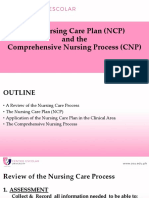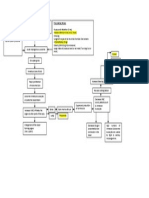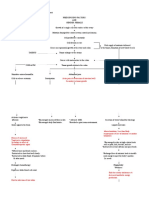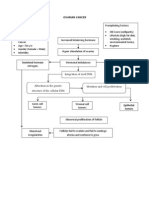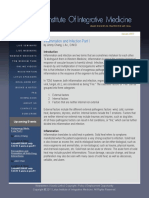0 ratings0% found this document useful (0 votes)
165 viewsPathophysiology of Cervical Cancer: High Risk HPV (16, 18, 31)
Pathophysiology of Cervical Cancer: High Risk HPV (16, 18, 31)
Uploaded by
Moses Gabriel Valledor1. High risk HPV (types 16 and 18) infects and integrates into the basal cells of the cervical squamous epithelium, blocking tumor suppressor genes p53 and pRB and causing abnormal cell growth.
2. This leads to cervical intraepithelial neoplasia (CIN) and squamous intraepithelial lesions (SIL) as mutated cells proliferate.
3. Without treatment, CIN/SIL can progress to invasive cervical cancer where the tumor fills the cervix and spreads to distant organs via lymphatic or blood vessels.
Copyright:
© All Rights Reserved
Available Formats
Download as DOCX, PDF, TXT or read online from Scribd
Pathophysiology of Cervical Cancer: High Risk HPV (16, 18, 31)
Pathophysiology of Cervical Cancer: High Risk HPV (16, 18, 31)
Uploaded by
Moses Gabriel Valledor0 ratings0% found this document useful (0 votes)
165 views2 pages1. High risk HPV (types 16 and 18) infects and integrates into the basal cells of the cervical squamous epithelium, blocking tumor suppressor genes p53 and pRB and causing abnormal cell growth.
2. This leads to cervical intraepithelial neoplasia (CIN) and squamous intraepithelial lesions (SIL) as mutated cells proliferate.
3. Without treatment, CIN/SIL can progress to invasive cervical cancer where the tumor fills the cervix and spreads to distant organs via lymphatic or blood vessels.
Original Title
patho cervical
Copyright
© © All Rights Reserved
Available Formats
DOCX, PDF, TXT or read online from Scribd
Share this document
Did you find this document useful?
Is this content inappropriate?
1. High risk HPV (types 16 and 18) infects and integrates into the basal cells of the cervical squamous epithelium, blocking tumor suppressor genes p53 and pRB and causing abnormal cell growth.
2. This leads to cervical intraepithelial neoplasia (CIN) and squamous intraepithelial lesions (SIL) as mutated cells proliferate.
3. Without treatment, CIN/SIL can progress to invasive cervical cancer where the tumor fills the cervix and spreads to distant organs via lymphatic or blood vessels.
Copyright:
© All Rights Reserved
Available Formats
Download as DOCX, PDF, TXT or read online from Scribd
Download as docx, pdf, or txt
0 ratings0% found this document useful (0 votes)
165 views2 pagesPathophysiology of Cervical Cancer: High Risk HPV (16, 18, 31)
Pathophysiology of Cervical Cancer: High Risk HPV (16, 18, 31)
Uploaded by
Moses Gabriel Valledor1. High risk HPV (types 16 and 18) infects and integrates into the basal cells of the cervical squamous epithelium, blocking tumor suppressor genes p53 and pRB and causing abnormal cell growth.
2. This leads to cervical intraepithelial neoplasia (CIN) and squamous intraepithelial lesions (SIL) as mutated cells proliferate.
3. Without treatment, CIN/SIL can progress to invasive cervical cancer where the tumor fills the cervix and spreads to distant organs via lymphatic or blood vessels.
Copyright:
© All Rights Reserved
Available Formats
Download as DOCX, PDF, TXT or read online from Scribd
Download as docx, pdf, or txt
You are on page 1of 2
Pathophysiology of Cervical Cancer
High risk HPV (16, 18, 31) Risk factors:
Early age of coitus
Invasion of the basal cell of the Multiple sexual partners
squamous epithelium of the Unsafe sexual practices
cervix
Integration of viral DNA
p53 and pRB tumor suppressor
genes are blocked/deactivated Barrel-shaped
cervix
Mutation and cell proliferation
CIN/SIL Tumor fills the entire
Co-carcinogens
Carcinoma in situ cervix
Metastasis to distant body parts
Invasive cancer Tissue necrosis and
sloughing
Increased tumor growth
Lymph invasion
Hypermetabolic Increased
activitypressure to the surrounding tissues, nerves and bladder Fistula formation Hemorrhage Infection
of cell proliferation and Enlargement of lymph
increased tumor growth nodes
needs Leakage of
Metrorrhagia Foul-
urine and
Pelvic and back pain Venous and Ureteral Bleeding smelling
Dysuria feces into the
obstruction after coitus vaginal
vagina
Anorexia anemia discharge
Weight
Hydronephrosi Leg edema
loss
s
You might also like
- DSM 5 - DSM 5Document7 pagesDSM 5 - DSM 5Roxana ClsNo ratings yet
- Pathophysiology: Precipitating FactorDocument6 pagesPathophysiology: Precipitating FactorMark Anthony YabresNo ratings yet
- IM - Leptospirosis Concept MapDocument3 pagesIM - Leptospirosis Concept MapTrisNo ratings yet
- Cervical Cancer Patho.2Document2 pagesCervical Cancer Patho.2Verni Dela CruzNo ratings yet
- Patho DengueDocument3 pagesPatho DengueKayshey Christine ChuaNo ratings yet
- Cancer Schematic DiagramDocument1 pageCancer Schematic DiagramCyrus De Asis100% (4)
- Final Ovarian Cancer Meigs Pathophysio PDFDocument3 pagesFinal Ovarian Cancer Meigs Pathophysio PDFCathy Santos100% (1)
- Benign Prostatic Hyperplasia - BPH - Pathophysiology - Schematic DiagramDocument2 pagesBenign Prostatic Hyperplasia - BPH - Pathophysiology - Schematic DiagramSimran JosanNo ratings yet
- Pathophysiology of Pulmonary Embolism (Loria.J)Document2 pagesPathophysiology of Pulmonary Embolism (Loria.J)Justine Mae Loria67% (3)
- Pa Tho Physiology of Hiatal HerniaDocument1 pagePa Tho Physiology of Hiatal HerniaChiskie Faldas Genodia100% (1)
- Instruction: Do The Following Activities That Will Serve As Your Formative Assessment. Activity 1: CompletionDocument10 pagesInstruction: Do The Following Activities That Will Serve As Your Formative Assessment. Activity 1: CompletionMoses Gabriel Valledor50% (2)
- D F-Elevated Blood Pressure DDocument2 pagesD F-Elevated Blood Pressure DMenly SusadaNo ratings yet
- Communicable 3Document9 pagesCommunicable 3Mj Ganio0% (1)
- Peanut Component Testing BrochureDocument4 pagesPeanut Component Testing BrochureDiyan NurisnawatiNo ratings yet
- Pathophysiology of Inflammatory ResponseDocument1 pagePathophysiology of Inflammatory ResponseDeo FactuarNo ratings yet
- MYOMA PathoDocument1 pageMYOMA Pathobsn2011100% (1)
- Pathophysiology-Ng Hirschsprung DiseaseDocument3 pagesPathophysiology-Ng Hirschsprung DiseaseJan Rae Barnatia AtienzaNo ratings yet
- Pathophysiology (Client Base) :: Predisposing Factors: Precipitating FactorsDocument1 pagePathophysiology (Client Base) :: Predisposing Factors: Precipitating Factorsleslie_macasaetNo ratings yet
- Pathophysiology Cholelithiasis 2Document2 pagesPathophysiology Cholelithiasis 2Jamie HaravataNo ratings yet
- Amoebiasis PathophysiologyDocument3 pagesAmoebiasis PathophysiologyApril CornejoNo ratings yet
- Marjorie A. Carganilla BSN 3-2 Pathophysiology of Urinaryy Tract Infection Precipitating FactorsDocument8 pagesMarjorie A. Carganilla BSN 3-2 Pathophysiology of Urinaryy Tract Infection Precipitating FactorsMarjorie Carganilla100% (1)
- Pathophysiology-Kni Ns PLZZZDocument8 pagesPathophysiology-Kni Ns PLZZZAnna Lira Manluyang MungcalNo ratings yet
- Pathophysiology of Lower Urinary Tract InfectionDocument1 pagePathophysiology of Lower Urinary Tract InfectionSTORAGE FILENo ratings yet
- V. Pathophysiology Modifiable: Non - ModifiableDocument2 pagesV. Pathophysiology Modifiable: Non - ModifiableMary Grace BanezNo ratings yet
- Pathophysiology of Multiple Myeloma OkDocument3 pagesPathophysiology of Multiple Myeloma OkRifa'atul MahmudahNo ratings yet
- NCP and CNPDocument37 pagesNCP and CNPDen TupasNo ratings yet
- Pathophysiology (Book-Based) : CystitisDocument9 pagesPathophysiology (Book-Based) : CystitisIrish EspinosaNo ratings yet
- CHOLANGITISDocument1 pageCHOLANGITISKirk Torregosa PañaresNo ratings yet
- Patho For Lung CancerDocument3 pagesPatho For Lung Cancermycah_myrabellNo ratings yet
- Pathophysiology Precipitsting Factors: Predisposing FactorsDocument2 pagesPathophysiology Precipitsting Factors: Predisposing FactorsGeofrey MaglalangNo ratings yet
- Schistosomiasis (From Anatomy To Pathophysiology)Document10 pagesSchistosomiasis (From Anatomy To Pathophysiology)Tiger Knee100% (1)
- Angina Pectoris PathophysiologyDocument2 pagesAngina Pectoris PathophysiologyALIANA KIMBERLY MALQUESTONo ratings yet
- CeVD, MI, HCVD & Atrial Fibrillation PathophysiologyDocument3 pagesCeVD, MI, HCVD & Atrial Fibrillation PathophysiologyJjessmar Bolivar FamaNo ratings yet
- Course of Illness:: ClassificationDocument2 pagesCourse of Illness:: ClassificationKrista P. AguinaldoNo ratings yet
- C. Pathophysiology (Schematic Diagram) Predisposing Factors Precipitating FactorsDocument2 pagesC. Pathophysiology (Schematic Diagram) Predisposing Factors Precipitating FactorsMarynette MapaNo ratings yet
- Acute GlomerulonephritisDocument1 pageAcute GlomerulonephritisTaz Bagul MutiNo ratings yet
- Pathophysiology of Acute Gastroenteritis: Perforati-NgDocument1 pagePathophysiology of Acute Gastroenteritis: Perforati-NgBryan Voltaire Santos LannuNo ratings yet
- DiverticulitisDocument2 pagesDiverticulitisyapyapvinx50% (2)
- PathophyDocument2 pagesPathophymharz_astilloNo ratings yet
- Group 3 Pathophysiology-of-BREAST-CANCERDocument1 pageGroup 3 Pathophysiology-of-BREAST-CANCERArisa VijungcoNo ratings yet
- Pathophysiology of Hyperemesis Gravidarum DiagramDocument1 pagePathophysiology of Hyperemesis Gravidarum DiagramQuintin MangaoangNo ratings yet
- Pathophysiology of AMLDocument1 pagePathophysiology of AMLjake251996100% (1)
- 4 ConceptDocument1 page4 ConceptStacey GarciaNo ratings yet
- Patof DMDocument1 pagePatof DMxerwaneNo ratings yet
- Pathophysiology of Gastrointestinal Bleeding Secondary To Bleeding PolypsDocument1 pagePathophysiology of Gastrointestinal Bleeding Secondary To Bleeding PolypsGinoTevesNo ratings yet
- Pa Tho Physiology of Hodgkin'sDocument10 pagesPa Tho Physiology of Hodgkin'sIvica Rae100% (1)
- Urinary Tract Infection Anatomy and PhysiologyDocument12 pagesUrinary Tract Infection Anatomy and PhysiologyPaul Anthony Centeno PimentelNo ratings yet
- Copd PathoDocument2 pagesCopd PathoAlvin RamirezNo ratings yet
- Cholelithiasis PathophysiologyDocument2 pagesCholelithiasis PathophysiologyShinrin SukehiroNo ratings yet
- Ovarian Cancer, The NEw PathophyDocument3 pagesOvarian Cancer, The NEw PathophylieselannjacobNo ratings yet
- Adenomyosis PathophysiologyDocument1 pageAdenomyosis PathophysiologyZerfa NishreenNo ratings yet
- Pathophysiology of Pressure UlcerDocument1 pagePathophysiology of Pressure UlcerSTORAGE FILENo ratings yet
- Acute Lymphoblastic Leukemia Pathophysiology: Predisposing Factors: Etiology: Precipitating FactorsDocument3 pagesAcute Lymphoblastic Leukemia Pathophysiology: Predisposing Factors: Etiology: Precipitating FactorsKyla ValenciaNo ratings yet
- Pathophysiology CholelithiasisDocument2 pagesPathophysiology CholelithiasisLovely DaroleNo ratings yet
- Liver Cirrhosis: Precipitating Factors: Predisposing FactorDocument22 pagesLiver Cirrhosis: Precipitating Factors: Predisposing FactorJorie RocoNo ratings yet
- Pathophysiology of UgibDocument1 pagePathophysiology of UgibChombe JcNo ratings yet
- Ovarian Cancer PathoDocument1 pageOvarian Cancer PathoKevin Miguel Rivera100% (2)
- Diabetes PathoDocument2 pagesDiabetes Pathodrewcel100% (1)
- Pathophysiology Cushing S SyndromeDocument4 pagesPathophysiology Cushing S SyndromeMaria Luisa VillalunaNo ratings yet
- Pathophysiology of Pressure UlcersDocument1 pagePathophysiology of Pressure UlcersSTORAGE FILENo ratings yet
- TOF (Pathophysiology)Document4 pagesTOF (Pathophysiology)Doreen Claire M. WallangNo ratings yet
- AGE PathophysiologyDocument1 pageAGE PathophysiologyZhenmei0% (1)
- B. Diagram: Predisposing Factors: Precipitating Factors EtiologyDocument3 pagesB. Diagram: Predisposing Factors: Precipitating Factors EtiologyKenneth Torres100% (1)
- Pathophysiology (Normal Spontaneous Vaginal Delivery)Document2 pagesPathophysiology (Normal Spontaneous Vaginal Delivery)Jose Bryan NacillaNo ratings yet
- Ventricular Septal Defect, A Simple Guide To The Condition, Treatment And Related ConditionsFrom EverandVentricular Septal Defect, A Simple Guide To The Condition, Treatment And Related ConditionsNo ratings yet
- PathoianDocument1 pagePathoianMoses Gabriel ValledorNo ratings yet
- Religious Involvement 8Document1 pageReligious Involvement 8Moses Gabriel ValledorNo ratings yet
- Pathophysiology-Threatened MiscarriageDocument1 pagePathophysiology-Threatened MiscarriageMoses Gabriel ValledorNo ratings yet
- CamScanner 08-05-2020 06.19.56Document22 pagesCamScanner 08-05-2020 06.19.56Moses Gabriel ValledorNo ratings yet
- Journal NSTPDocument1 pageJournal NSTPMoses Gabriel ValledorNo ratings yet
- CFE - Religious Involvement (April 18, 2021)Document1 pageCFE - Religious Involvement (April 18, 2021)Moses Gabriel ValledorNo ratings yet
- VALLEDOR - GECOS-Module 2 SAQDocument6 pagesVALLEDOR - GECOS-Module 2 SAQMoses Gabriel ValledorNo ratings yet
- MOSES GABRIEL VALLEDOR - ACTIVITY - NSTP-2-Module-3-Short-Term-2020Document3 pagesMOSES GABRIEL VALLEDOR - ACTIVITY - NSTP-2-Module-3-Short-Term-2020Moses Gabriel ValledorNo ratings yet
- MOSES GABRIEL G. VALLEDOR - GECOS - Module 5 SAQ - FinalDocument2 pagesMOSES GABRIEL G. VALLEDOR - GECOS - Module 5 SAQ - FinalMoses Gabriel ValledorNo ratings yet
- Moses Gabriel Valledor - Journal - July 14Document1 pageMoses Gabriel Valledor - Journal - July 14Moses Gabriel ValledorNo ratings yet
- CFE - Religious Involvement Week 3Document1 pageCFE - Religious Involvement Week 3Moses Gabriel ValledorNo ratings yet
- Module 1: You and The World You Live inDocument2 pagesModule 1: You and The World You Live inMoses Gabriel ValledorNo ratings yet
- Module 1: You and The World You Live inDocument5 pagesModule 1: You and The World You Live inMoses Gabriel ValledorNo ratings yet
- MOSES GABRIEL VALLEDOR - Evaluation-Unit 3Document2 pagesMOSES GABRIEL VALLEDOR - Evaluation-Unit 3Moses Gabriel ValledorNo ratings yet
- Module 1: You and The World You Live inDocument2 pagesModule 1: You and The World You Live inMoses Gabriel ValledorNo ratings yet
- A Specific Abnormal Scattergram of Peripheral Blood Leukocytes That May Suggest Hairy Cell LeukemiaDocument4 pagesA Specific Abnormal Scattergram of Peripheral Blood Leukocytes That May Suggest Hairy Cell Leukemiatufis02No ratings yet
- Based On Latest CDC Data The Wuhan Coronavirus Poses Virtually No Death Risk Whatsoever For People UnDocument2 pagesBased On Latest CDC Data The Wuhan Coronavirus Poses Virtually No Death Risk Whatsoever For People UnamacmanNo ratings yet
- Psychiatric Mental Health Case StudyDocument11 pagesPsychiatric Mental Health Case Studyapi-546332329No ratings yet
- Drug Study ONG CaseDocument3 pagesDrug Study ONG Casereized02No ratings yet
- Exercise Approach To Scoliosis CompressedDocument22 pagesExercise Approach To Scoliosis CompressedMarko MaricNo ratings yet
- Fdar - Sandra - Pyloric Stenosis - FinalDocument3 pagesFdar - Sandra - Pyloric Stenosis - FinalCheryl Moana Marie FedelisNo ratings yet
- Cost Analysis of An Intensive Care UnitDocument7 pagesCost Analysis of An Intensive Care UnitSabrina JonesNo ratings yet
- DW AnxietyDocument11 pagesDW AnxietywojtaszekNo ratings yet
- Ineffective Tissue Perfusion PDFDocument4 pagesIneffective Tissue Perfusion PDFgcodouganNo ratings yet
- MRCP UL Neuro OnlyDocument14 pagesMRCP UL Neuro OnlyRebecca Teng Siew YanNo ratings yet
- New Drug Developmen (OR) Drug Discovery: Saminathan Kayarohanam M.Pharm, M.B.A, PHDDocument20 pagesNew Drug Developmen (OR) Drug Discovery: Saminathan Kayarohanam M.Pharm, M.B.A, PHDSaminathan KayarohanamNo ratings yet
- Adhd EssayDocument3 pagesAdhd Essayapi-241238813No ratings yet
- Pediatrics Interactive TOACS Examination PDFDocument136 pagesPediatrics Interactive TOACS Examination PDFsmjavailableNo ratings yet
- Infantile Hypertrophic Pyloric StenosisDocument25 pagesInfantile Hypertrophic Pyloric StenosisPirapong Invalueable KunokNo ratings yet
- Dr. DEEPAK.N.S (PG), Dr. PAGADPALLY SRINIVAS (Professor & Head) Dept. of Paediatrics, VMMC, KKLDocument2 pagesDr. DEEPAK.N.S (PG), Dr. PAGADPALLY SRINIVAS (Professor & Head) Dept. of Paediatrics, VMMC, KKLSumanth KumarNo ratings yet
- Open Letter To FDA On Its Response To MRC's Citizen Petition RE The Vascepa SNDADocument56 pagesOpen Letter To FDA On Its Response To MRC's Citizen Petition RE The Vascepa SNDAMedical Research Collaborative, LLCNo ratings yet
- Rubric For Tabata WorkoutDocument3 pagesRubric For Tabata WorkoutLuisa RadaNo ratings yet
- Health Law Project - Aditya Pratap Singh and Mohd AazamDocument13 pagesHealth Law Project - Aditya Pratap Singh and Mohd AazamRishabh AroraNo ratings yet
- Philippine Cerebral PalsyDocument6 pagesPhilippine Cerebral PalsyRon DoguilesNo ratings yet
- Inflammation and Infection Part I: by Jimmy Chang, L.Ac., O.M.DDocument3 pagesInflammation and Infection Part I: by Jimmy Chang, L.Ac., O.M.DShahul HameedNo ratings yet
- 02 Nutrition and Nutritional DisordersDocument114 pages02 Nutrition and Nutritional DisordersMateen ShukriNo ratings yet
- Factors That Affect Normal Functioning of The Older PersonsDocument7 pagesFactors That Affect Normal Functioning of The Older Personslouie john abila100% (1)
- Ki-67 Labeling Index Is A Predictor of Postoperative Persistent Disease and Cancer Growth and A Prognostic Indicator in Papillary Thyroid CarcinomaDocument8 pagesKi-67 Labeling Index Is A Predictor of Postoperative Persistent Disease and Cancer Growth and A Prognostic Indicator in Papillary Thyroid CarcinomajameeraNo ratings yet
- Advances in Vestibular Rehabilitation: Shaleen Sulway Susan L. WhitneyDocument6 pagesAdvances in Vestibular Rehabilitation: Shaleen Sulway Susan L. WhitneymykedindealNo ratings yet
- Cost Effectiveness AnalysisDocument13 pagesCost Effectiveness Analysisfarmasi ANo ratings yet
- Vet. Internal Medicine Text BookDocument674 pagesVet. Internal Medicine Text Bookuhgl hgluvtm100% (5)

























